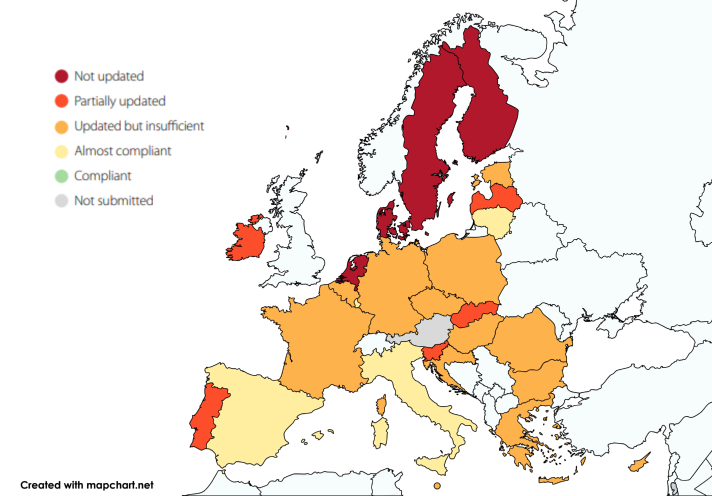
The update of the National Energy and Climate Plans (NECPs) is essential to ensure the implementation of the Energy Efficiency Directive starts off on the right foot. A recent analysis by the Coalition for Energy Savings indicates that the efficiency dimension of the NECPs must be significantly strengthened, with particular emphasis on streamlining the energy efficiency-first principle and addressing energy poverty, among other elements.
The adoption of the 2023 Energy Efficiency Directive (EED) marks a significant milestone for the Fit for 55 Package, enhancing the existing legal framework for energy efficiency and promising to accelerate action at the national level thanks to its stronger provisions. EU countries must now turn the EED into reality and promptly implement it so to contribute to EU energy independence, competitiveness for industry and lower bills for citizens, particularly the most vulnerable.
Update of the NECPs: a crucial first step towards effective implementation
The update of the NECPs is a pivotal first step in ensuring the objectives of the Fit for 55 Package are met and the revised legislation, including the EED, is correctly implemented. While the new provisions of the 2023 EED must be transposed into national legislation by October 2025, the NECP updates must drive this exercise and serve as a planning tool to put countries on the right path towards achieving the 2030 EU energy efficiency objective, starting now.
However, with less than three months left before the deadline to submit the final plans by the end of this June, EU Member States must significantly improve their draft NECP updates; many of these drafts lack details, do not align with the new 2030 climate and energy objectives and present considerable weaknesses.
Our recently published analysis, which evaluates whether the available 26 draft NECP updates adequately reflect the new provisions of the 2023 EED and the Governance Regulation, reveals that no draft plan is fully compliant with the new requirements (NB: at the time of writing our analysis, Austria had not submitted yet its draft NECP update). Only four out of the 26 countries have submitted draft plans that are ‘almost compliant’ with new EED. 13 countries have submitted draft plans that do not consistently address the new elements of the EED in an adequate manner (‘updated but insufficient’), five countries have only ‘partially updated’ their NECPs, neglecting to consider most, if not all, of the new key 2023 EED requirements, and four countries do not reflect the requirements of the new EED at all in their plans (see Picture 1).
Picture 1: Overall compliance of draft NECP update with the 2023 EED
How to best integrate the new energy efficiency requirements in the final NECPs updates
The encouraging news is that the planning process is still ongoing and there is still room to enhance the robustness of the final NECPs and ensure full compliance with the new obligations of the EED, including by integrating the Commission’s country-specific recommendations. Based on our comprehensive analysis, the following key points must be addressed as a matter of priority by EU countries in finalising their plans:
- Set adequate national objectives: national energy efficiency contributions must be sufficient and accurately reflect each country’s share of the EU 2030 energy efficiency target. The Commission communicated to Member States corrected contributions, and recommended Member States to increase their ambition where necessary. Those contributions must now be included in the final NECP updates.
- Streamline the EE1st principle: The EE1st principle must serve as an organizing principle for the entire NECP, not just reflected in the energy efficiency dimension of the plan. The positive benefits of energy savings across sectors must be properly valued and fully captured.
- Prioritise alleviating energy poverty: Despite the recent increase in energy poverty, most draft NECP updates miss the opportunity to plan measures to make the energy transition more inclusive for all. In particular, the energy poverty sub-target and specific actions to save energy among energy-poor households under the Energy Savings Obligations are too frequently missing.
- Accelerate action in the public sector: reducing consumption in the public sector is essential to showcase the benefits of efficiency and spur market transformation. The lack of focus on EED Article 5 (public sector leading on energy efficiency), Article 6 (exemplary role of public bodies’ buildings) must be rectified, and Member States must define objectives and measures to reduce the public sector’s energy consumption.
Final NECPs must become a useful tool for planning the necessary course of actions to successfully implement the 2023 EED. All Member States must urgently start to put in place additional measures, catalyse investments, engage with citizens, and mobilise stakeholders and local authorities to save energy across sectors.
Recommended links
- Planning for the 2023 EED: are EU Countries up to the task? Updated analysis, April 2024 | The Coalition for Energy Savings (energycoalition.eu)
- The new 2023 Energy Efficiency Directive: Guidance for planning and implementation | The Coalition for Energy Savings (energycoalition.eu)
About the author
Arianna Vitali Roscini is Secretary General at the Coalition for Energy Savings since 2021. The Coalition strives to make energy efficiency and energy savings the first consideration of energy policies; it unites businesses, local authorities, energy agencies, energy communities and civil society organisations in pursuit of this goal. Before joining the Coalition, Arianna was Senior Policy Advisor at BPIE where she managed research projects and steered BPIE work related to the Renovation Wave. Previous to that, she was part of the climate and energy team of the WWF European Policy Office, where she coordinated WWF advocacy on energy savings in Europe.
Disclaimer: This article is a contribution from a partner. All rights reserved.
Neither the European Commission nor any person acting on behalf of the Commission is responsible for the use that might be made of the information in the article. The opinions expressed are those of the author(s) only and should not be considered as representative of the European Commission’s official position.
Details
- Publication date
- 25 April 2024
- Author
- European Climate, Infrastructure and Environment Executive Agency

